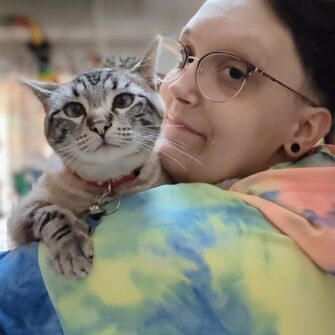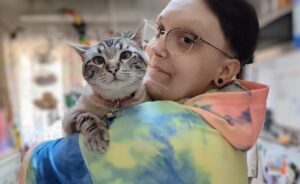
Against the odds: Experimental treatment helps Autumn achieve remission of rare cancer
When 24-year-old Autumn Park (they/them) began experiencing migraines, it was easy to write them off as a product of stress.
After all, it was 2020 — as COVID-19 spread across the globe, Park, an essential worker, was employed at a grocery store while also caring for a disabled family member.
But over the course of a year, the migraines were followed by other symptoms — nasal congestion, nosebleeds, fatigue and swelling in the neck. Multiple trips to urgent care brought no definitive answers and no lasting relief.
Concerned, Park’s boyfriend urged them to seek help one more time, so Park went to a local emergency department.
“When I pulled down my mask in the exam room, there was so much swelling in my sinuses that the provider examining me gasped,” Park says.
Tests would reveal a mass in Park’s sinuses, a form of cancer called alveolar rhabdomyosarcoma.
Despite being in their 20s, Park was referred to MultiCare Mary Bridge Children’s Hospital, where a clinical trial testing an investigational treatment for this cancer was being offered. The trial was likely their best chance at long-term remission.
While weighing the options, they thought about more than their own well-being.
“My cancer was stage 4 — my odds for survival weren’t good,” Park says. “But whether I lived or died, I wanted my suffering to mean something. If participating in the trial would help someone, whether it was a year from now or 50 years from now, I wanted to do that.”
Location makes a difference
It’s not unusual for someone of Park’s age to receive treatment for cancer at a children’s hospital. They fall into a group of patients between the ages of 15 and 39 referred to as adolescents and young adults (AYAs).
“Patients in this age group can get cancers that are more commonly found in young children or older adults,” says Rebecca Johnson, MD, Park’s primary oncologist at Mary Bridge Children’s and a nationally recognized expert in AYA medicine. “AYA patients with cancers that are pediatric in nature tend to have better outcomes when they are treated in a pediatric rather than an adult setting.”
This was the case for Park — rhabdomyosarcoma is usually diagnosed in children and teens. According to the American Cancer Society, rhabdomyosarcoma represents about 3 percent of all childhood cancers.
“In most areas of medicine, the handoff from a pediatric to an adult provider happens once and it goes in one direction,” says Dr. Johnson. “But AYA cancer care is unique. It requires ongoing communication and treatment planning between oncologists on the adult and pediatric side. We’ve built that system here at MultiCare to ensure patients — regardless of their age — are getting treatment in the right setting and access to appropriate clinical trials.”
Key ingredients of AYA cancer care
AYA patients with cancer have unique needs. Comprehensive AYA services include:
- Fertility preservation
- Access to clinical trials
- Clinical expertise
- Psychosocial support (such as psychotherapy and social work services)
- Opportunities for AYA patients to connect with one another
In 2016, Dr. Johnson was the principal investigator for a Patient-Centered Outcomes Research Institute (PCORI) project that gathered information from AYA cancer survivors, family members and the MultiCare professionals who cared for them. This group became the Tacoma AYA Oncology Council.
Hear what the council has to say about AYA care in this video.
Improving the standard of care through research
While research has led to many advances in the treatment of childhood cancers, improving outcomes for metastatic rhabdomyosarcoma — the kind of cancer Park had — remains an area of opportunity. (Metastatic means the cancer has spread to other parts of the body.)
“Over the past 20 or 30 years there hasn’t been much progress in how we treat this particular type of tumor, so outcomes haven’t improved much since the 1990s,” says Jacob Henderson, MD, a member of Park’s treatment team at Mary Bridge Children’s. “Long-term survival for patients with metastatic rhabdomyosarcoma is less than 20 percent.”
Another complicating factor for Park was the location of their primary tumor. Surgery — sometimes part of standard treatment — would be disfiguring and possibly fatal.
After considering their options, Park agreed to pursue the investigational treatment. The Phase 2 trial, offered in collaboration with the MultiCare Institute for Research and Innovation, was testing a combination of chemotherapy and radiation.
In a Phase 2 study, researchers are aiming to learn more about the safety of a treatment and how well it works. Should the treatment prove both safe and effective, it will move on to further rounds of testing.

Autumn Park holding their 2-year-old cat Zuko, whose companionship helped them get through treatment.
Park, like many patients in the South Sound area, was grateful to enroll in a study that was close to home.
“Traveling long distances to access experimental treatments can be a real burden, especially when a person is dealing with the unknowns of a cancer diagnosis,” says Julianne Pugh, RN, clinical research associate at the Research Institute. “Many people do not have the resources to travel, and less travel means more time they can spend focusing on their health.”
Better outcomes through collaboration
As part of the Children’s Oncology Group (COG) — a national network of children’s hospitals and research organizations — Mary Bridge Children’s can support access to clinical trials, like the one Park participated in. COG trials investigate new and emerging treatments, supportive care, as well as issues children face in survivorship.
Perseverance pays off
Having a treatment plan in place brought a slight measure of relief for Park, but it did not diminish the arduous path that lay ahead. Over the next year, Park endured multiple rounds of chemotherapy, a round of radiation and a two-month inpatient stay at Mary Bridge Children’s Hospital.
“I spent my 25th birthday in the hospital,” Park says. “The Mary Bridge team was so kind to me — they made me little cards and gave me a little pillowcase and some things so I could color to try to keep myself busy.”
At times during treatment, Park wanted to give up, particularly when the radiation to their mouth and throat made it impossible to talk or swallow. For several months, Park had to receive nutrition via a feeding tube.
However, in March 2023, shortly after a final dose of chemotherapy, Park would learn that their perseverance had paid off — scans showed no signs of disease.
“It was so emotional,” Park says. “I hadn’t really expected to live through this, and here I was … not only just alive but in complete remission.”
In addition to the experimental treatment, Park credits the care they received at Mary Bridge Children’s for saving their life.
“I’ve dealt with a lot of medical issues in my time — my own and my families’ — so I’m no stranger to hospitals,” they say. “Mary Bridge is a special place — I found it really calming to be there. The doctors, the nurses and everyone was just so friendly and welcoming to me.”
Today, Park remains in remission and is making good on a promise they made to themselves during treatment.
“I told myself that if I survived this, I was going to go to college and become an accountant, so I’ll be starting classes at Bates Technical College this fall.”
Learn more about research and clinical trials at Mary Bridge Children’s.